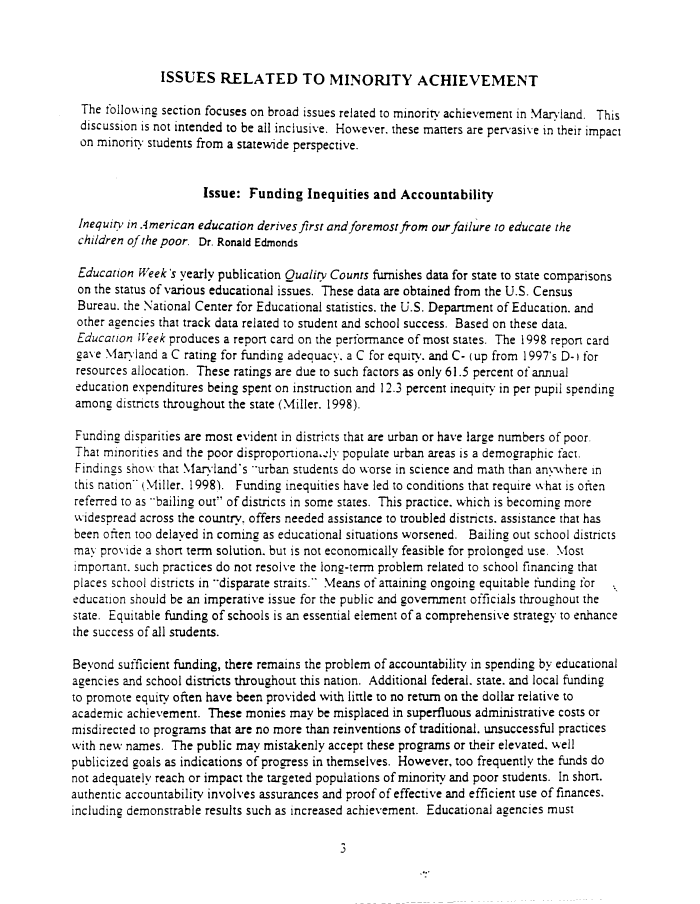 |
||||
|
TASK FORCE TO STUDY THE HISTORY AND LEGACY OF SLAVERY IN MARYLAND (Final Report) 1999/12/31 MdHR 991422 MdHR 991422, Image No: 182 Print image (88K) |
 |
||||
|
TASK FORCE TO STUDY THE HISTORY AND LEGACY OF SLAVERY IN MARYLAND (Final Report) 1999/12/31 MdHR 991422 MdHR 991422, Image No: 182 Print image (88K) |
| ISSUES RELATED TO MINORITY ACHIEVEMENT The following section focuses on broad issues related to minority achievement in Man-land. This discussion is not intended to be all inclusive. However, these matters are pervasive in iheir impaci on minority students from a statewide perspective. Issue: Funding Inequities and Accountability Inequity in American education derives first and foremost from our failure to educate the children of the poor. Dr. Ronald Edmonds Education Week's yearly publication Quality Counts furnishes data for state to state comparisons on the status of various educational issues. These data are obtained from the U.S. Census Bureau, the National Center for Educational statistics, the U.S. Department of Education, and other agencies that track data related to student and school success. Based on these data. Education Week produces a report card on the performance of most states. The 1998 repon card gave Maryland a C rating for funding adequacy, a C for equity, and C- (up from 1997's D-) for resources allocation. These ratings are due to such factors as only 61.5 percent of annual education expenditures being spent on instruction and 12.3 percent inequity in per pupil spending among districts throughout the state (Miller. 1998). Funding disparities are most evident in districts that are urban or have large numbers of poor. That minorities and the poor disproportionately populate urban areas is a demographic fact. Findings show that Maryland's "urban students do worse in science and math than anywhere in this nation" (Miller. 1998). Funding inequities have led to conditions that require what is onen referred 10 as "bailing our' of districts in some states. This practice, which is becoming more widespread across the country, offers needed assistance to troubled districts, assistance that has been often too delayed in coming as educational situations worsened. Bailing out school districts may provide a short term solution, but is not economically feasible for prolonged use. Most important, such practices do not resolve the long-term problem related to school financing that places school districts in "disparate straits." Means of attaining ongoing equitable funding lor education should be an imperative issue for the public and government officials throughout the state. Equitable funding of schools is an essential element of a comprehensive strategy to enhance the success of all students. Beyond sufficient funding, there remains the problem of accountability in spending by educational agencies and school districts throughout this nation. Additional federal, state, and local funding to promote equity often have been provided with little to no return on the dollar relative to academic achievement. These monies may be misplaced in superfluous administrative costs or misdirected to programs that are no more than reinventions of traditional, unsuccessful practices with new names. The public may mistakenly accept these programs or their elevated, well publicized goals as indications of progress in themselves. However, too frequently the funds do not adequately reach or impact the targeted populations of minority and poor students. In short, authentic accountability involves assurances and proof of effective and efficient use of finances, including demonstrable results such as increased achievement. Educational agencies must |